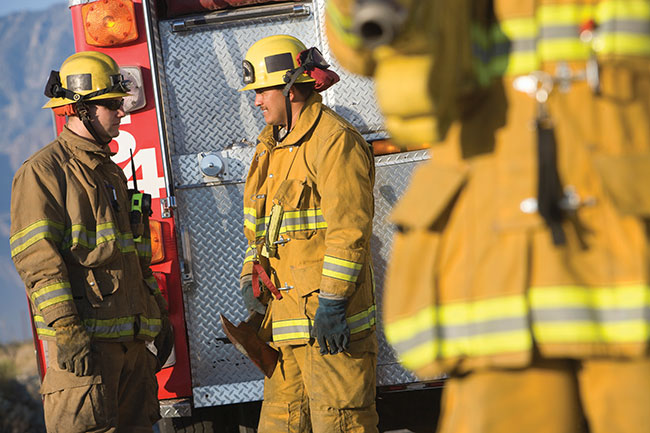
Safety in training: Examining the dangers of ‘No Duff’ calls
By Dave Robertson
Features Training canadian firefighter firefighter training training Photo credit: moodboard / Adobe Stock
Photo credit: moodboard / Adobe Stock While the modern-day firefighter is typically an “all-hazards” responder, and a Mayday can be called in any situation, for the purposes of this article I’ll be concentrating on the fireground and fire training.
The number of fires a firefighter responds to is decreasing, and the nature of modern-day fire dynamics—with fires reaching flashover points exponentially faster than in previous years—is such that firefighters are showing up past the point of committing to an interior attack. Because of this lack of real fire “mileage”, instructors now strive to create fireground training scenarios that mimic the real stresses of an emergency. With that more realistic training ground, as well as the proliferation of Mobile Live Fire Training Units like the Ontario Fire Marshal’s MLFTU, the chance of a training injury – or worse – increases. Training for realism already means that training-related injuries are commonplace. In an NFPA study of 2021 firefighter injuries in the United States, since there are no readily available Canadian numbers, there were 8,125 injuries during training activities.1
While writing this article, I was reminded that the “Firefighter Survival” and “Calling the Mayday” trainings typically appear in my calendar during the month of May; I also fold these into as much fireground training as possible throughout the rest of the year.
During one training session several years ago, when briefing crews on the safety plan for a series of training evolutions, I was asking the crew that if they got into trouble, what should they call out? “Mayday!” the group answered in unison. Just then, the lead instructor stepped in and said, “You mean ‘No Duff.’”
At first, I thought he was trying to be funny. Then he pointed to two words written in bold on his Training Safety Plan: “No Duff”, to be called by a firefighter in serious trouble on the training ground.
I let it go at the time, but I didn’t understand. Why would we train repeatedly and in various scenarios to call a “Mayday” if we were in trouble, to then not use it? How can we teach from both the IFSTA and Jones & Bartlett texts—including the Canadian editions—that calling a Mayday is a lifeline? There is also the Mayday Project, a well-known analysis of close calls and line-of-duty deaths that involved calling a Mayday. Finally, articles abound in the fire service trade magazines on the topic of Maydays, from managing them from a command perspective and RIT teams, to when to call one. In short, our frontal lobes, (i.e., “muscle memory”), have carved a path for calling the Mayday in a critical situation.
So, why do all of these communications exist in teaching and training to call the Mayday, but on Canadian training grounds we call “No Duff”?
Incidentally, a Mayday isn’t solely for fireground work. A Mayday can, indeed when needed should, be called on any emergency scene.
First, let’s start with a little history.
“No Duff” is an old Royal Air Force (RAF) term. Prior to radar, triangulation of radio towers, called “Directional Finding” (DF), was used to locate aircraft. If during a training exercise a real message was being transmitted, it was predicated with “NoDF”, meaning the situation was not part of the training. Over time, this transformed into “No Duff”. It has sparse usage across other parts of the Commonwealth, specifically in Australia and England, but it’s especially prevalent here in Canada.
But why is calling “No Duff” so dangerous? Well, let’s look back to the myriad and ubiquitous message that “Mayday” equals severe trouble. Any time a firefighter or crew is in a life-threatening situation where only the help of others on scene will guarantee that firefighter’s survival, a Mayday is called. When that happens, ideally all emergency radio traffic becomes dedicated to managing the Mayday, and all actions on scene are directed towards the aid and rescue of the firefighter needing help.
Now imagine a situation like the one found during the previously mentioned live fire training, a live scenario technical rescue, or the actual destruction of vehicles in auto extrication training, in which a firefighter falls through the floor of an acquired structure for a live burn or has a malfunctioning SCBA in smoke out conditions. It’s at this point that we demand the firefighter switches gears and use verbiage not trained on, not common in fire service practice, not even tested on when taking their initial NFPA 1001?
It’s a recipe for a tragedy. Training accidents happen all the time. Do you want to be the chief explaining in front of cameras that it’s yet another example of a fire department, “It’s just how we do things” situation? Because in World War II we did it, so we continue to?
It’s my belief that it’s time to stop the practice, immediately, and get in line with the rest of the fire service.
Reference
- Campbell, Richard and Shelby Hall. “United States Firefighter Injuries.” National Fire Protection Association. Accessed at https://www.nfpa.org/Education-and-Research/Research/NFPA-Research/Fire-Statistical-reports/Firefighter-injuries-in-the-United-States.
Chief Dave Robertson has 25 years in the fire service in five different departments, from busy urban systems to wildland to rural/semi-rural. He has instructed within his fire departments, in fire academies, paramedic schools, private fire institutions, and as a Chief of Training. He is fueled by a deeply sincere passion to make the fire service better.
Print this page
Advertisement
- Police investigating arson after third fire this month at Collingwood tire shop
- 1 dead after fire breaks out at Toronto shelter